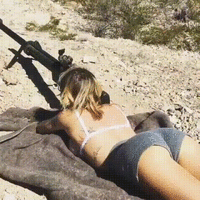Beretta92FS
NES Member
If you enjoy the forum please consider supporting it by signing up for a NES Membership The benefits pay for the membership many times over.
Be sure to enter the NES/MFS May Giveaway ***Canik METE SFX***
That's a man baby!
Here is a challenge for a scientific and artistically inclined shooter...
Can somebody create a satellite image with a distance scale at the bottom showing an animated arc and bullet flight at 2 miles???
I think it would show the "gravity" of the circumstance of a 2 mile shot.
It would be so cool to have an overhead view of the bullet flight on my computer screen to show how fast a bullet can cover 2 miles to scale on a computer screen.
It actually takes a few seconds if I recall.
Bussy and shenis. Nice
No shit. She's adding tools to her optics, making calculations on her notepad, professional spotter. JFC. What's she shooting? 50BMG?Holy crap that is a LONG way.
I think this one was .375 CheytacNo shit. She's adding tools to her optics, making calculations on her notepad, professional spotter. JFC. What's she shooting? 50BMG?
I have to admit that it is impressive to put rounds on target at over 2 miles, but can't help but wonder how much is the shooter and how much is the equipment.
You run out of adjustment on your scope and they add that periscope optic to the front of the scope or the target would not even be visible. At 2 miles bullet drop is over 200 feet and a 5mph wing pushes the round more than 25 feet. It's like lobbing the round over a 20 story building.
The margin of error gets pretty small at that distance, and minute variations in wind and the bullet are amplified, so conditions have to be favorable and the equipment precise. Not something you can do with a Winchester Model 70.
Sights? We don't need sights for just 2 miles, that calls for shooting from the hipSomeone here will be out shortly claiming they can do that all day long, with nothing more than iron sights on any service rifle made after 1890 and factory ammunition.
LOL - and they would be full of shit.Someone here will be out shortly claiming they can do that all day long, with nothing more than iron sights on any service rifle made after 1890 and factory ammunition.
Years ago when 1 mile was a big deal, or maybe it was 2 miles, anyways, a magazine did an article on the feat. They delved into what it took and all. They broke down a line item price sheet and surprisingly the weapon wasn't the expensive part, it was the weather and thermal imagery that enabled the info to make that shot. It was something along the lines of $140k in equipment with the rifle and optics only being $14k of it. The optic of the time was some Vortex razor HD @ $4,300. I think now that same optic is under $2k.Nice! Though I have to wonder how much a setup like that costs to make that kind of shot.
Mosin Nagant, iron sights, surplus ammo, while standing, 20mph wind.Someone here will be out shortly claiming they can do that all day long, with nothing more than iron sights on any service rifle made after 1890 and factory ammunition.
"When I was 19, I did a guy in Laos from1000 yards out. Rifle shot in high wind...."Mosin Nagant, iron sights, surplus ammo, while standing, 20mph wind.
I just have no concept of how fast a bullet flies.Depends on which direction they shot at. I would think firing due north or south would be least desirable. But the coolest overhead view.
Even cooler - Take the shot from the North Pole. I bet that would be interesting.
And I assume we are BOTH assuming geosynchronous type situation for the observation post.
Besides @Cuthbert Allgood , who's gonna want to watch your butt while you shoot some ridiculously powerful caliber?Why the distinction of being a female ? I mean there is nothing about making a shot like that where a female is at a disadvantage.
AR15 bullet: Up to 3260 ft/sec; which is .617 miles/sec; or 2,221.2 MPH.Depends on which direction they shot at. I would think firing due north or south would be least desirable. But the coolest overhead view.
Even cooler - Take the shot from the North Pole. I bet that would be interesting.
And I assume we are BOTH assuming geosynchronous type situation for the observation post.

Besides @Cuthbert Allgood , who's gonna want to watch your butt while you shoot some ridiculously powerful caliber?

Been watching for 10 minutes now.
Just don't try explaining this to @GregBeen watching for 10 minutes now.
Does she ever run out of bullets???
That rear end checks all my boxes and is dialed in real nice.
It's the ideal cut for rear ends.
Before long she'll have me shooting blanks.
